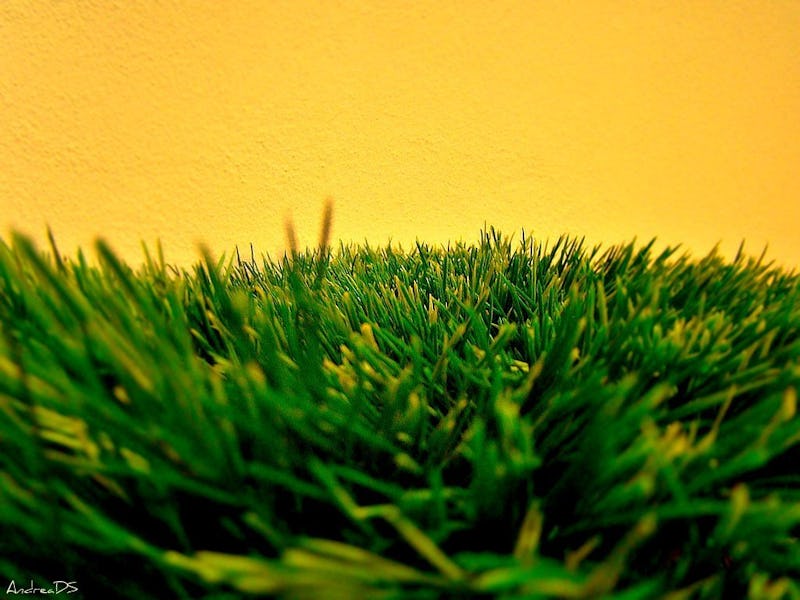California's Drought Has Triggered a Synthetic Turf War
Where the grass is always greener because it can’t die.

Four years into a historic drought, the Golden State is browning around the edges and a turf war is gaining momentum. As state officials urge Californians to abandon their thirsty lawns — the average American patch sucks down 10,000 gallons of water per year — for the sake of ecology and economy, people are looking for alternative ways to spend green to make green. That’s where Victor Lanfranco, major player in the fake grass game, comes in. He’s looking to capitalize and, unless the ecologically minded score a propaganda coup, he’s likely to do just that.
Lanfranco, who runs jolly turf giant Synthetic Grass Warehouse, told Inverse that it’s shaping up to be a bumper year for fake grass. Last year, Americans installed about 110 million square feet of synthetic grass. In 2015, Lanfranco says, the square footage of turf laid down is on track to double to 220 million.
As you might expect, Lanfranco waxes hyper-enthusiastic about the grass he sells. The stuff put down in front yards, which goes by names like Tiger Turf or Nature’s Blend, is “10 light-years ahead of AstroTurf,” he says. (You get the sense that if AstroTurf had a grave, Lanfranco would be dancing on it.) That precursor to synthetic lawns, the uniform cartoon-green carpet first introduced to the world via the Houston Astrodome, was manufactured using “very ancient techniques.”
What does 10 light-years in grass technology get you? Here’s the SGW sales pitch: Polypropylene or recycled-petroleum monofilaments, distributed individually in different sizes that sprout across a lush landscape. The blades have had the Crayola crayon treatment: Each filament is one of four or five green shades with every eighth blade dyed brown for verisimilitude.
“What we’re trying to do is look exactly like real grass,” Lanfranco says. “The only difference is you don’t need to cut, water, or fertilize it.”
If a ticker on his website is to be believed, Tiger Turf has saved the world 47 billion gallons of water since January 2008. The last major hurdle for synthetic grass to overcome, as he sees it, is that left to broil in the sun these plastic lawns have a tendency to get warm. (Or, as it were, unbearably hot). But a new, cooler yarn formulation is on the horizon. And unlike the sports turf, there’s no underlying layer of crumb rubber, which in Lanfranco’s opinion negates the carcinogen issue.
But according to Laurel Warddrip of the California State Water Resources Control Board, installing synthetic grass is like putting a band-aid on a scar. Fake grass can’t sequester carbon or nitrogen the way plants do, so it makes it hard for the surface to breathe. Plus, there’s a churning microbial ecosystem, which winds through the roots around topsoil, that acts as a biological filter for stormwater. Without the critters in the topsoil, Warddrip worries that pollutants could sheet off fake lawns and into drains.
Warddrip champions a third path between water-guzzling lawns or synthetic grass: the “drought-friendly” landscape. Here, native plants accustomed to the drought or desert environments replace lawns.
“These yards are beautiful,” she says. “You get birds and bees, and low use, if at all, of pesticides.” There are vouchers in many areas of California that make these comparable in cost, she says, if not cheaper than synthetic grass. Environmental groups have created planting guides for a variety of local California climates, with river-, bay- and ocean-friendly vegetation matrices.
Despite this push for natural landscapes, synthetic grass isn’t going anywhere. It’s good to be Victor Lanfranco right now. And Victor Lanfranco thinks it’s going to be good to be him for some time. The guy sees potential everywhere: At pet parks! Stretched across the tops of buildings! In shopping malls! In those booths you see at John Deere expos! In Seattle “where it rains!”
Lanfranco may, in fact, be on to something when he wants to cover a planet in artificial turf — just not ours. He was approached, Lanfranco says, by a California scientist putting together a model of what a Mars habitat would look like 60 years in the future. You wouldn’t be able to ship synthetic grass to Mars — it’s too heavy — but what about manufacturing it there? That’s a great idea, Lanfranco says. And don’t stop once you’ve turned the Red Planet green: “The Moon would be a great area for artificial turf.”